A great online store is more than just a pretty layout; it's a powerful sales engine. The best ecommerce website design seamlessly blends stunning visuals with intuitive functionality, guiding visitors from their first click to the final checkout. It builds trust, tells a compelling brand story, and makes the shopping experience feel effortless.
But with countless platforms and design trends, identifying what truly works can be a challenge. Understanding the foundational technology is a crucial first step. While this guide focuses on design examples, an in-depth content management system comparison can help you evaluate the core platforms like Shopify and WordPress before you even consider aesthetics.
This listicle breaks down exceptional ecommerce examples, revealing the specific strategies they use to turn browsers into buyers. We'll analyze what works, why it works, and how you can apply these proven tactics to your own business. Each example includes screenshots and direct links to help you explore. Forget generic advice; you will find actionable takeaways and replicable methods to build a high-converting digital storefront that drives real growth for your brand. Let's dive into the designs that are setting the standard for online retail.
1. Shopify: The All-in-One Conversion Machine
Shopify has earned its top spot by providing a robust, all-in-one platform that prioritizes one thing above all else: converting visitors into customers. While it's a platform for building stores rather than a single website, its core architecture is a masterclass in the best ecommerce website design principles. It empowers entrepreneurs to create beautiful, high-performing online stores without needing deep technical knowledge.
The platform’s primary advantage lies in its meticulously optimized infrastructure. From lightning-fast page load speeds to the famously streamlined Shopify Checkout, every element is engineered to reduce friction and guide users toward a purchase. This focus on conversion is what sets it apart from many competitors.
Strategic Breakdown
Shopify’s design philosophy centers on a powerful combination of simplicity and extensibility. The user interface for merchants is incredibly intuitive, making daily operations like inventory management and order fulfillment straightforward. For customers, the front-end experience is consistently clean and reliable, regardless of the theme a store uses.
Key Insight: Shopify's success isn't just about pretty templates; it's about the underlying conversion science. The platform relentlessly A/B tests and refines its core features, especially its checkout process, giving every merchant access to an enterprise-level sales funnel.
Actionable Takeaways for Your Business
To make the most of Shopify, focus on leveraging its ecosystem.
- Theme Selection: Start with a premium, mobile-first theme from the Shopify Theme Store. These are pre-vetted for speed, performance, and adherence to modern design standards.
- App Integration: Use the App Store strategically. Add apps for functions like customer reviews (e.g., Yotpo), email marketing (e.g., Klaviyo), and advanced analytics, but avoid bloating your site with unnecessary scripts that can slow it down.
- Payment Flexibility: Enable multiple payment options through Shopify Payments to cater to diverse customer preferences. To further enhance Shopify's capabilities as a conversion machine, consider exploring options for integrating cryptocurrency payments with Shopify, which can attract a new, tech-savvy customer segment.
- Multichannel Selling: Connect Shopify to social media channels like Instagram and Facebook to sell directly where your audience spends their time.
By combining a well-chosen theme with strategic app integrations, you can build a store on Shopify that not only looks professional but is also a finely tuned conversion machine.
2. BigCommerce: The Feature-Rich Scalability Engine
BigCommerce positions itself as a powerful alternative for serious merchants who crave robust, built-in functionality without relying heavily on third-party apps. It offers a sophisticated platform where the best ecommerce website design is achieved through deep customization and a wealth of native features. This approach is ideal for businesses, especially in the B2B space or those managing complex catalogs, that need more control out-of-the-box.
The platform’s core strength is its feature-rich architecture. Unlike competitors that often require apps for essential functions, BigCommerce includes advanced SEO tools, promotional engines, and multi-storefront capabilities natively. This reduces "app bloat," leading to potentially faster, more stable sites and a lower total cost of ownership over time.
Strategic Breakdown
BigCommerce’s design philosophy is built on providing an open, flexible foundation for growth. It empowers developers and store owners with greater API access and less restrictive design limitations than some other hosted solutions. This makes it a go-to for established brands planning to scale or those with unique technical requirements.
Key Insight: BigCommerce’s competitive edge is its commitment to providing comprehensive native features. By building core functionalities like faceted search and B2B quoting directly into the platform, it frees merchants from the maintenance and cost associated with a large stack of third-party applications.
Actionable Takeaways for Your Business
To leverage the full power of BigCommerce, you need to think beyond the basics.
- Utilize Native Features: Dive deep into the built-in promotional tools and SEO settings. BigCommerce offers powerful options for setting up complex discounts and has strong out-of-the-box SEO, which you can learn more about in this guide to mastering online store SEO.
- Embrace Headless Commerce: For maximum design flexibility, consider a headless approach using BigCommerce's APIs. This allows you to build a completely custom front-end on a modern framework while leveraging BigCommerce’s robust backend for checkout and catalog management.
- Plan for Growth: Be mindful of the plan-based revenue thresholds. While BigCommerce doesn't charge extra transaction fees, you will be automatically upgraded to a higher plan once you cross a certain annual revenue limit. Factor this into your financial projections.
- B2B and International: If you serve B2B clients or sell internationally, activate the native features for customer groups, bulk pricing, and multi-currency support to create a tailored user experience.
3. WooCommerce: The Ultimate in Customization and Control
For businesses that want total ownership and limitless customization, WooCommerce stands out as the premier open-source solution. As a plugin for WordPress, it transforms the world’s most popular content management system into a powerful and flexible ecommerce engine. This approach grants merchants complete control over their store’s design, functionality, and data, making it a top contender for the best ecommerce website design for those with specific needs.
WooCommerce’s main appeal is its freedom. Unlike hosted platforms, it allows you to choose your own hosting, modify the underlying code, and build a truly bespoke shopping experience from the ground up. This makes it ideal for brands with unique product configurations, complex business models, or those who want to integrate content and commerce seamlessly.
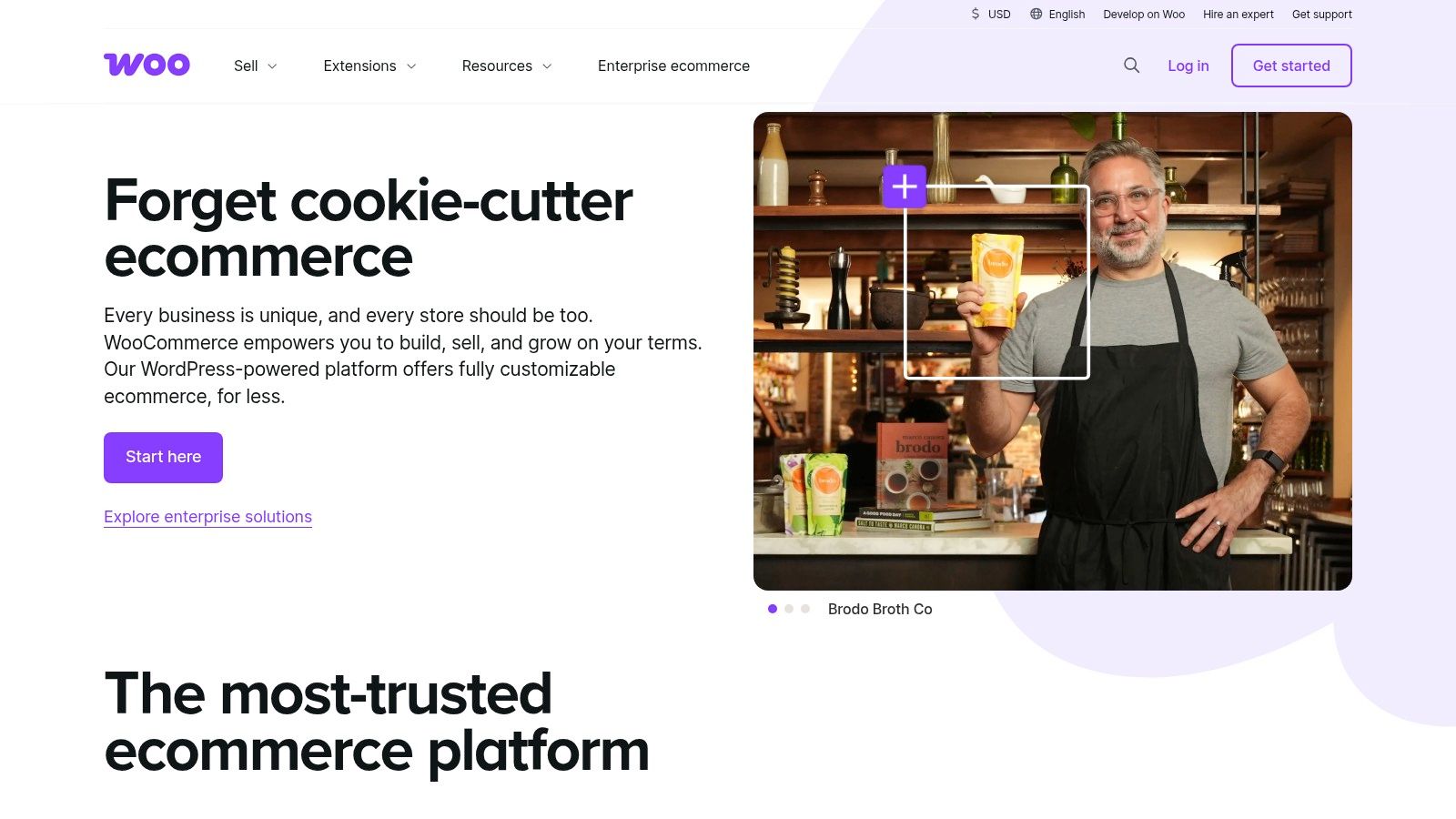
Strategic Breakdown
WooCommerce’s design philosophy is built on the extensibility of WordPress. It provides a solid ecommerce foundation that can be infinitely expanded through themes and plugins. While the core plugin is free, the real power comes from its vast ecosystem, which offers everything from advanced shipping calculators to B2B wholesale portals and subscription management tools.
Key Insight: WooCommerce empowers you to build an asset, not just rent a storefront. Full control over hosting and code means your store is a portable, independent entity. You are responsible for security and performance, but in return, you get unparalleled design freedom and avoid the platform fees common with other services.
Actionable Takeaways for Your Business
To succeed with WooCommerce, focus on building a stable and scalable foundation.
- Hosting is Key: Choose a high-quality managed WordPress host (e.g., Kinsta, WP Engine) that specializes in WooCommerce. This will handle critical performance and security tasks, freeing you up to focus on design and sales.
- Curate Your Plugins: The plugin ecosystem is massive but varied. Stick to well-reviewed, frequently updated extensions from reputable developers to avoid security vulnerabilities and performance bottlenecks.
- Invest in a Premium Theme: Start with a well-coded theme like Astra or GeneratePress, paired with a page builder like Elementor. This combination provides a flexible and visually intuitive way to design your store without writing code.
- Plan for Maintenance: Since you own the stack, you are responsible for updates. For those new to the platform, exploring a detailed comparison can help determine if WooCommerce is the right ecommerce platform for a beginner.
By carefully selecting your hosting, theme, and plugins, you can leverage WooCommerce to create a highly customized and powerful online store that perfectly matches your brand vision.
4. Wix eCommerce: The Design-First Storefront Builder
Wix eCommerce secures its spot by offering a highly intuitive, design-first platform perfect for brands that prioritize visual appeal and brand identity. While Shopify focuses on a conversion-optimized framework, Wix excels at providing unparalleled creative freedom through its drag-and-drop editor, making it a leader in best ecommerce website design for those with a strong visual concept. It empowers entrepreneurs to build stunning, custom-looking storefronts without writing a single line of code.
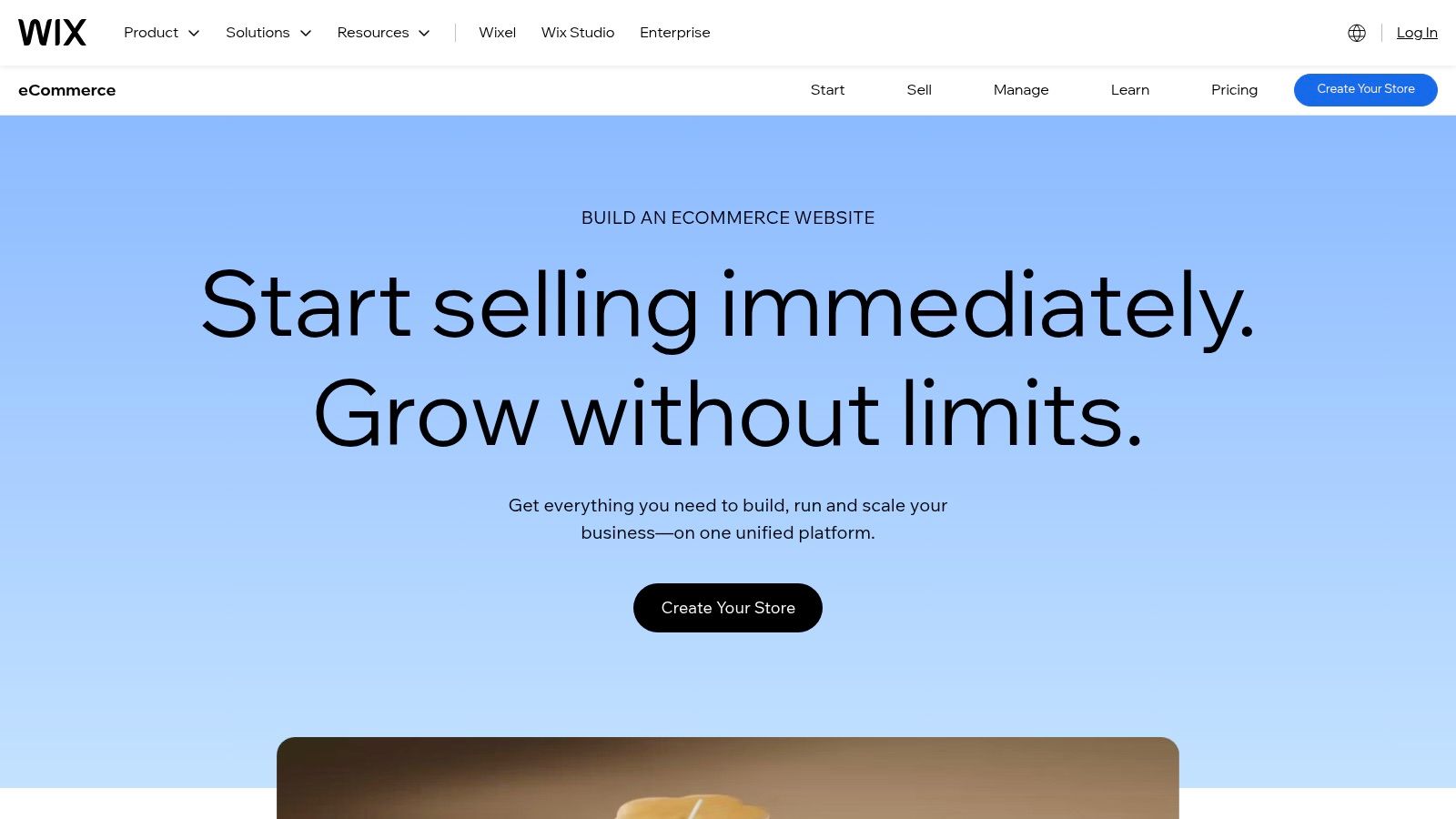
The platform’s core strength is its flexibility. With over 900 professionally designed templates and AI-assisted design tools, Wix makes it exceptionally fast to launch a polished ecommerce site. It handles all the technical aspects like hosting, security, and payments, allowing business owners to concentrate purely on design, branding, and selling their products.
Strategic Breakdown
Wix’s design philosophy is centered on visual control and accessibility. The platform gives users granular control over every element on the page, from font spacing to image placement, which is a significant advantage for brand-conscious businesses. This is coupled with a robust backend that includes integrated payment processing, inventory management, and multichannel selling capabilities.
Key Insight: Wix's competitive edge is its ability to blend ease of use with deep design customization. While other platforms lock users into rigid templates, Wix provides a free-form canvas, allowing businesses to create a truly unique brand experience that stands out in a crowded market.
Actionable Takeaways for Your Business
To build a high-performing store with Wix, capitalize on its design flexibility without sacrificing functionality.
- Template Customization: Start with one of the 900+ templates as a foundation, but don't be afraid to customize it heavily. Use the drag-and-drop editor to move elements, change color palettes, and create a layout that perfectly matches your brand's aesthetic.
- Leverage Wix Apps: Explore the Wix App Market to add powerful features. Integrate apps for loyalty programs, advanced shipping solutions, and customer testimonials to enhance the user experience and drive sales.
- Optimize for Mobile: Use the dedicated mobile editor to ensure your store looks and functions flawlessly on smaller screens. Manually adjust mobile layouts to optimize the shopping experience, as this is where a significant portion of traffic originates.
- Utilize AI Tools: Take advantage of Wix's AI tools to generate business names, create logos, and even write product descriptions. These features can significantly speed up the setup process and help you launch faster.
5. Squarespace Commerce: The Aesthetic Powerhouse
Squarespace has long been the go-to platform for creatives and brands focused on stunning visual presentation. Its ecommerce offering, Squarespace Commerce, extends this design-first philosophy to online selling, providing an integrated solution that prioritizes aesthetic elegance and simplicity. While other platforms focus on extensibility, Squarespace delivers a curated, all-in-one experience that empowers businesses to build a professional, visually-driven storefront with minimal effort.
The platform’s core strength lies in its award-winning, mobile-optimized templates. Every design is meticulously crafted to look beautiful out of the box, ensuring a premium user experience across all devices. This focus on a polished front-end makes it a top contender for the best ecommerce website design, especially for brands where product presentation is paramount.
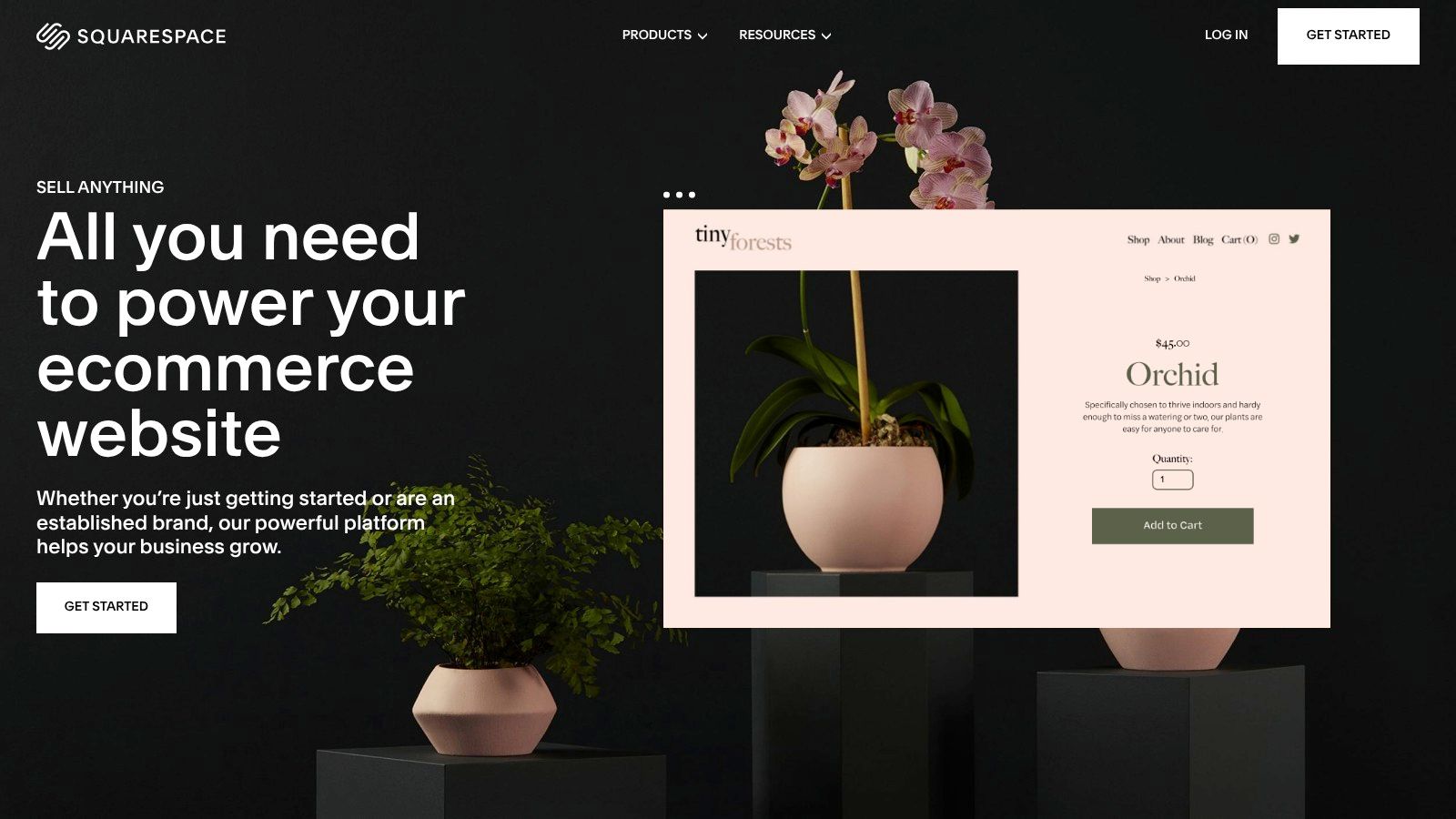
Strategic Breakdown
Squarespace Commerce's strategy is built on providing a controlled yet powerful ecosystem. Unlike the vast, open app markets of its competitors, it offers a more contained set of high-quality, built-in features. This includes everything from customer accounts and integrated shipping label printing to automatic U.S. sales tax calculations. The result is a highly reliable and cohesive system where every part is designed to work together seamlessly.
Key Insight: Squarespace bets that for many businesses, a beautiful, reliable, and simple-to-manage store is more valuable than infinite customization. Its on-domain checkout and unified toolset reduce complexity, allowing merchants to focus on their brand and products rather than technical maintenance.
Actionable Takeaways for Your Business
To leverage the full potential of Squarespace Commerce, focus on its inherent design strengths.
- Template as a Foundation: Choose a template that aligns with your brand’s visual identity and product photography. Since customization is more limited, your initial template choice is crucial.
- High-Quality Visuals: Invest heavily in professional product photography and videography. Squarespace's minimalist layouts are designed to make your visuals the star of the show.
- Utilize Built-in Tools: Master the integrated features for marketing, analytics, and inventory management before seeking third-party solutions. This keeps your site fast and your workflow simple.
- Know When to Go Custom: While Squarespace is excellent for many, businesses with highly specific functional needs may find its closed ecosystem limiting. For scenarios requiring advanced features not covered by Squarespace, exploring custom ecommerce development can provide a more tailored solution. You can learn more about custom e-commerce development on sugarpixels.com.
By embracing its design-centric approach and fully utilizing its integrated tools, you can create a sophisticated and effective online store on Squarespace that truly stands out.
6. Webflow Ecommerce: The Designer's Powerhouse
Webflow Ecommerce carves out its niche by offering unparalleled visual design control, making it the platform of choice for brands that refuse to be confined by templates. It merges a powerful visual canvas, a flexible content management system (CMS), and native ecommerce functionality, empowering designers and businesses to build truly bespoke online stores without writing code from scratch. This makes it a standout example of best ecommerce website design for those who prioritize brand identity and unique user experiences.
The platform’s core strength is its no-code visual designer, which gives you pixel-perfect control over every element, from the product grid to the checkout experience. Unlike template-driven platforms, Webflow allows for completely custom layouts, interactions, and animations, enabling a level of creative freedom typically reserved for custom-coded projects.
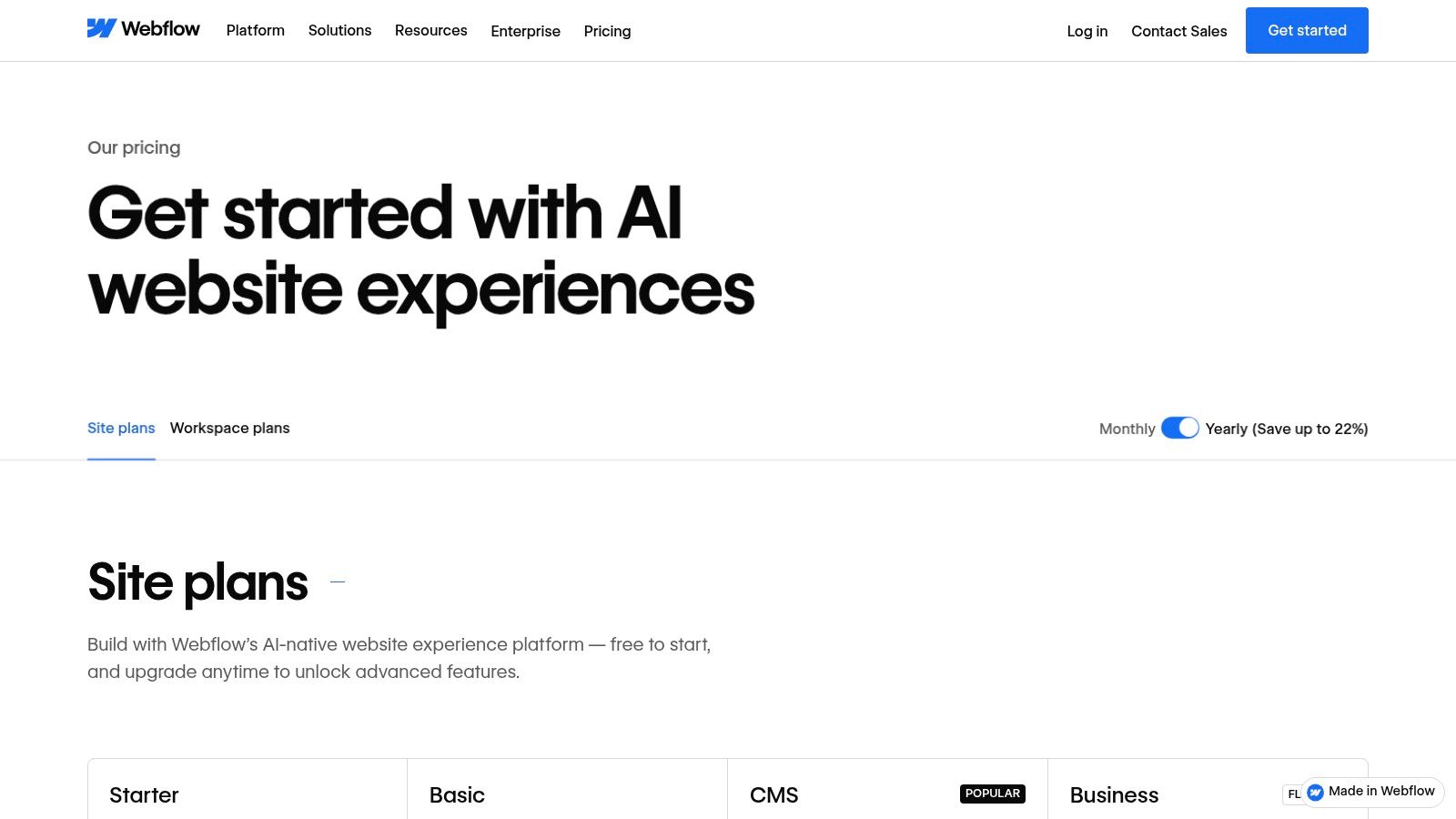
Strategic Breakdown
Webflow's design philosophy is about empowerment through control. It treats ecommerce elements like any other component in its designer, allowing you to style the cart, checkout pages, and product templates with the same granular precision you apply to a marketing landing page. This ensures a seamless and consistent brand experience from the first click to the final purchase confirmation.
The platform runs on high-performance hosting with an included SSL and CDN, ensuring that even visually rich sites load quickly. While it has a steeper learning curve than simpler builders, the payoff is a highly differentiated and performant storefront. Ecommerce plans come with item limits and transaction fees ranging from 0% to 2%, depending on the tier.
Key Insight: Webflow’s advantage is its ability to directly translate a unique brand vision into a functional, high-performance ecommerce site. It closes the gap between design and development, allowing for sophisticated, interaction-rich shopping experiences that stand out in a crowded market.
Actionable Takeaways for Your Business
To leverage Webflow Ecommerce effectively, embrace its design-first approach.
- Master the Designer: Invest time in learning the Webflow Designer. Understanding its box model, flexbox, and grid systems is crucial for unlocking its full potential and building a store that is both beautiful and structurally sound.
- Utilize the CMS: Connect your products to the Webflow CMS to create dynamic, content-rich product pages. This is perfect for building custom layouts for different product categories or integrating blog posts and user-generated content directly onto product pages.
- Customize the User Journey: Go beyond a standard layout. Design a custom cart and checkout experience that reinforces your brand identity and minimizes friction. Use Webflow's interaction engine to add subtle animations that guide the user and enhance the experience.
- Plan for Scale: Choose an ecommerce plan (https://webflow.com/pricing) that aligns with your product catalog size and projected sales volume to manage transaction fees and item limits effectively.
By fully utilizing its visual design and CMS capabilities, you can use Webflow to create a truly unique storefront that offers a memorable and conversion-focused customer experience.
7. Shopify Theme Store: The Foundation for High-Performance Design
While Shopify itself is the engine, the Shopify Theme Store is the official showroom for high-quality chassis and bodywork. It’s a curated marketplace of free and premium themes specifically engineered to leverage the full power of the Shopify platform. For any merchant, this is the safest and most effective starting point for creating a website that embodies the principles of the best ecommerce website design.
The store’s core value lies in its rigorous vetting process. Every theme listed, whether free or paid, is reviewed by Shopify for performance, accessibility, security, and compatibility with the latest features like Online Store 2.0. This curation eliminates much of the risk associated with third-party marketplaces, ensuring a baseline of quality and reliability for every merchant.
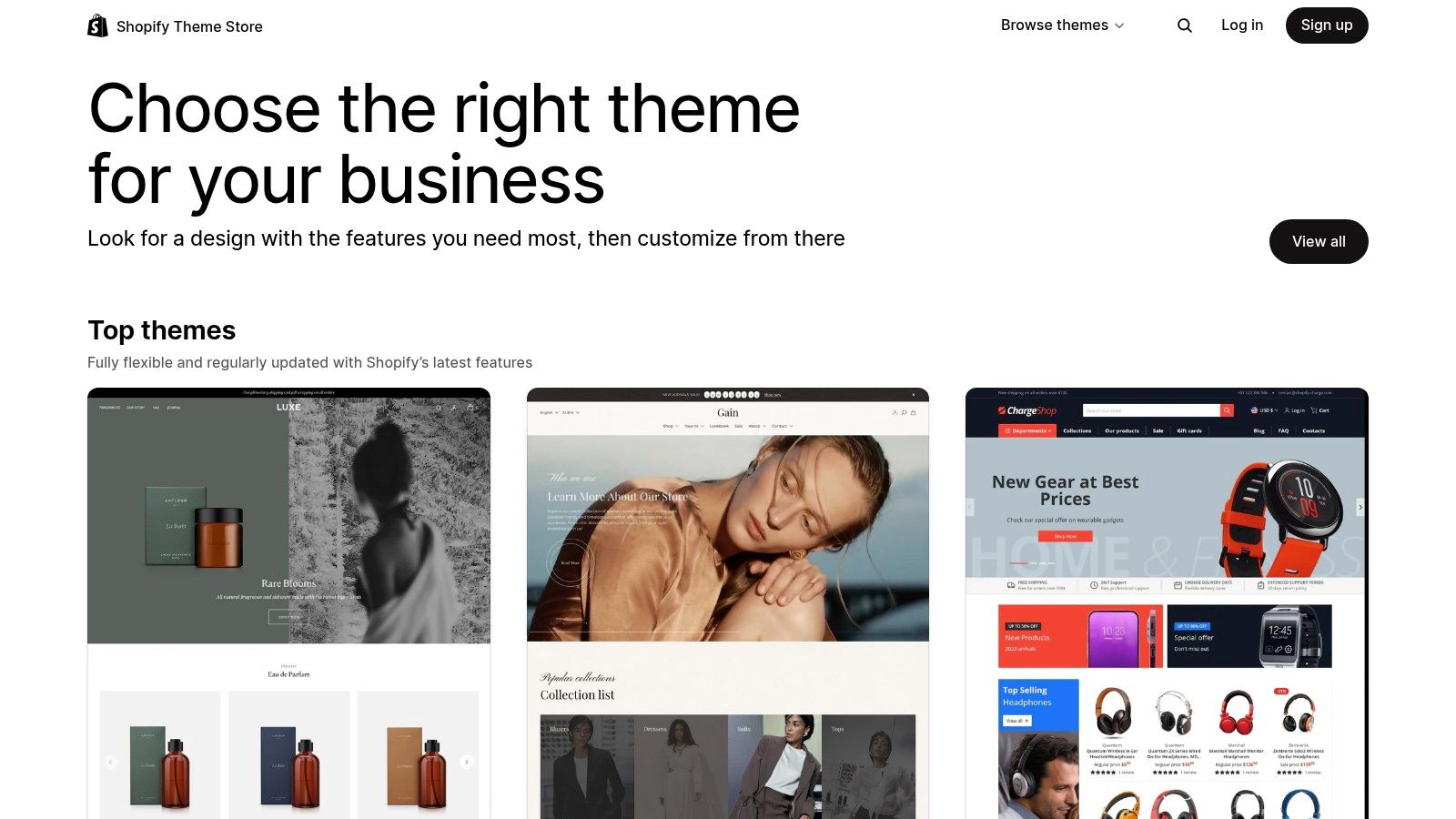
Strategic Breakdown
The design philosophy of the Shopify Theme Store is built on trust and performance. It empowers merchants to filter themes based on specific business needs, such as catalog size, industry, or features like sticky headers and quick-buy buttons. This allows for a strategic selection process that goes beyond simple aesthetics, focusing instead on the functional requirements of a successful online store.
Key Insight: The true advantage of the Shopify Theme Store is guaranteed forward compatibility. Themes are continuously updated by their developers to work seamlessly with new Shopify features, ensuring your store doesn't become obsolete and can always take advantage of the platform's latest conversion tools.
Actionable Takeaways for Your Business
To leverage the Shopify Theme Store effectively, approach it with a clear strategy.
- Filter with Intent: Don't just browse visually. Use the filters to narrow down options based on your inventory size, industry, and the specific merchandising features you need to drive sales, like enhanced product filtering or color swatches.
- Utilize the Trial Feature: All premium themes come with an unlimited free trial. Install and customize a theme with your own products, branding, and content to see exactly how it will perform before committing to a purchase.
- Check the "Works with" Section: Before buying, review a theme's details to see which popular apps it is guaranteed to be compatible with. This can prevent major headaches and ensure your essential tools work flawlessly from day one.
- Prioritize Speed and Mobile: Use the "View demo" feature to test a theme's mobile experience and run its demo URL through Google's PageSpeed Insights. A fast, mobile-first design is non-negotiable for modern ecommerce.
Top 7 Ecommerce Design Platforms Comparison
| Platform | Implementation Complexity 🔄 | Resource Requirements 💡 | Expected Outcomes 📊 | Ideal Use Cases 💡 | Key Advantages ⭐ |
|---|---|---|---|---|---|
| Shopify | Low – fast setup, hosted platform | Moderate – paid apps/developers for advanced customization | Reliable, scalable ecommerce with multichannel sales | US merchants seeking fast launch and scalability | Fast time-to-launch, vast app/theme ecosystem |
| BigCommerce | Moderate – native features reduce need for apps | Moderate – fewer apps, transparent plan costs | Strong SEO, native B2B, no extra payment fees | Merchants wanting robust out-of-the-box features | No transaction fees, solid SEO and catalog tools |
| WooCommerce | High – self-managed hosting and updates | High – hosting, security, and plugin costs | Full control, customizable, supports complex models | Advanced users wanting full design/control ownership | Maximum design freedom, large extension ecosystem |
| Wix eCommerce | Low – drag-and-drop with AI tools | Low to Moderate – bundled hosting, app costs can grow | Visually polished, quick launch storefronts | Beginners or SMBs wanting easy design and setup | Beginner-friendly, extensive templates, AI tools |
| Squarespace Commerce | Low to Moderate – limited extensions | Moderate – all-in-one pricing includes hosting | Elegant, mobile-optimized stores with built-in analytics | Professionals seeking professional look with ease | Sleek templates, simplified all-in-one stack |
| Webflow Ecommerce | High – pixel-level design control, moderate learning curve | Moderate – plan limits and transaction fees | Unique, highly customized storefronts | Agencies or users needing unique design without coding | Fine-grained design control, good performance |
| Shopify Theme Store | Low – theme marketplace for Shopify | Low – themes with updates and developer support | Optimized, compatible themes for Shopify stores | Merchants using Shopify wanting vetted design templates | Curated, updated themes with refund/trial options |
Putting It All Together: Your Blueprint for High-Converting Design
We've explored an array of powerful tools and analyzed stunning examples, but what’s the common thread weaving them together? The best ecommerce website design isn't just about aesthetics; it's a strategic fusion of user experience, brand storytelling, and technical performance. The most successful online stores, whether built on Shopify's robust framework or with Webflow's design-first flexibility, share a commitment to a core set of principles.
They prioritize a frictionless user journey from the first click to the final checkout confirmation. They communicate a strong, memorable brand identity through consistent visuals and compelling copy. Most importantly, they are built with a mobile-first mindset and optimized for lightning-fast load times, ensuring they meet the expectations of today’s demanding online shoppers.
Synthesizing the Key Takeaways
As you embark on your design or redesign journey, keep these foundational pillars at the forefront of your strategy. They are the constants that drive conversions, regardless of the platform you choose.
- Clarity Above All: A visitor should instantly understand what you sell and why it matters. This is achieved through clear navigation, high-quality product photography, and concise, benefit-driven product descriptions.
- Trust is Non-Negotiable: Build confidence with transparent shipping policies, easy-to-find contact information, genuine customer reviews, and secure payment badges. Every element should reinforce your credibility.
- Performance is a Feature: A slow website is a broken website. Optimize images, leverage browser caching, and choose a reliable hosting solution. Speed directly impacts user satisfaction and your bottom line.
- Brand Storytelling Sells: Don't just list products; tell a story. Use your "About Us" page, blog content, and even microcopy to connect with your audience on an emotional level, turning casual browsers into loyal brand advocates.
Your Actionable Next Steps
Feeling inspired? It's time to translate these insights into action. The first step is to honestly evaluate your specific business needs to select the right foundation for your project.
Choosing Your Platform:
- For all-in-one simplicity and scalability: Shopify and BigCommerce are industry leaders, offering comprehensive ecosystems that handle everything from payments to marketing.
- For content-rich stores on WordPress: WooCommerce provides unparalleled customization and control, perfect for businesses that already have a strong content marketing engine.
- For creative control and visual-first brands: Webflow Ecommerce and Squarespace Commerce empower designers and entrepreneurs to build visually stunning, custom experiences without writing code.
- For ease of use and quick setup: Wix eCommerce is an excellent starting point for small businesses and personal brands looking to get online quickly with user-friendly tools.
Ultimately, achieving the best ecommerce website design for your brand requires a thoughtful approach. Start by auditing your current site against the principles discussed. Identify the biggest friction points in your user journey and prioritize them. Then, armed with this knowledge, you can select the right tool and begin building a digital storefront that not only looks incredible but also performs flawlessly to drive sustainable growth.
If you're ready to build an online store that combines stunning visuals with conversion-focused strategy, the team at Sugar Pixels can bring your vision to life. We specialize in crafting custom ecommerce experiences that not only showcase your brand but also deliver measurable results. Let's build your perfect online store together at Sugar Pixels.